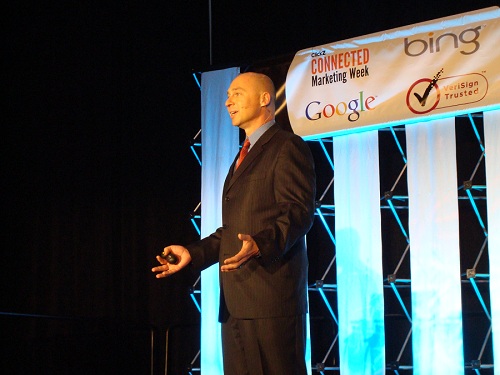 Websites and landing pages face very real trust issues – for consumers they can be a scary and uncertain place. Before people will take a desired action, their concerns and anxieties must be addressed. But how can you do this on landing pages when you only have seconds to establish trust?
Websites and landing pages face very real trust issues – for consumers they can be a scary and uncertain place. Before people will take a desired action, their concerns and anxieties must be addressed. But how can you do this on landing pages when you only have seconds to establish trust?
Tim Ash, SiteTuners CEO and bestselling author of Landing Page Optimization , shared how to effectively use the Four Pillars Of Trust and optimize your online conversion goals.
Tim started by reiterating what we know – it’s not about technology, it’s about people. If you’re going to transact with anyone it’s all about building trust.
We can’t function without trust, we are social beings. If we are going to cross the street, we have to trust that people driving cars will see the red light. Trust is critical, it’s the glue that holds everything together.
People weren’t designed to be in mobs, we have our “tribe” of a few dozen people that we trust and it breaks down into crowds.
Users understand “cheesy,” unprofessional sites vs. authoritative looking sites. So your site has to communicate authority instantly.
Four pillars of trust:
1. Appearance
We judge a book by its cover. Appearance is very important and a stand-in for fitness. Standards are rising in web development and it’s not okay to have a site which looks like it’s designed in 1998. There is a level of appearance and professionalism that is required in web development. Have 5 random people look at your homepage and answer: “is this clearly professional or not.”
Don’t get disqualified based solely on how you look. Focus on:
- Professionalism of design
- Sparseness and neatness
- Organization and clarity
2. Transactional assurances
I don’t know who you are and you don’t know who I am. Surveys say people are less and less afraid of getting online, but still 70% of users abandon shopping carts. It’s an issue of trust.
Include trust symbols and don’t bury them below the fold. If you’re paying for them, leverage them appropriately. Relieve point-of-action anxieties before they arise.
- Forms of payment and deliver
- Data security and privacy
- Policies and guarantees
3. Authority
We trust outside experts who provide a layer of authority. The trappings of authority are enough, such as uniforms or appearance. By association of authority figures or brands, that can transfer to your brand as well. We’ve seen authority symbols (such as “as seen in X or Y media outlets”) increased conversion rate by 40%. Figure out a way to leverage authority on your landing pages to boost conversions significantly.
Borrow trust from better-known brands such as:
- Reviews and awards
- Marquee clients
- Media mentions
- Trade associations
4. Consensus of peers
We don’t care what everyone thinks, we can’t possibly. We care by what our peers think. Are a lot of people taking the same action and have a positive outcome? Great, but are you sharing it with other users? Show specifics that are relevant to users.
Support automatic compliance by demonstrating social proof:
- Use objective, large numbers
- Likeness
Key takeaways
Take off the rose colored glasses and realize your website is ugly. The next step is to get to work and start to improve landing pages to increase conversions.


